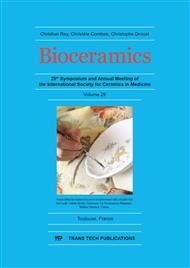p.204
p.210
p.217
p.223
p.228
p.234
p.239
p.245
p.250
Ceramic Roles in Aseptic Loosening: In Vivo Macro- and Microscopic Histological Evaluation
Abstract:
Prosthetic loosening in absence of infection (aseptic loosening) is the most common reason for revision of Total Hip Replacements (THR) Alumina and/or zirconia-based ceramic materials generally displayed high wear resistance and are considered suitable for load bearing application. To characterize the possible chronic cellular reactions to ceramic debris is then relevant in view of their long-term implantation. Low density ceramic pellets obtained by alumina and zirconia (Y-TZP) medical-grade precursors, were sintered at intermediate density and implanted in the patellar tendon of 24 NZW adult rabbits (group A). In this way the progressive release into the joint space of grains detached from surface of the pellets by the motion of the joint. Other 24 NZW rabbits (group B) received 5mg of powders injected in the articular capsule. Animals were killed at different intervals (1,3,6,12 months). Retrieved knee joints underwent X-Ray, histological and ultrastructural analysis. Peripheral organs (liver, kidney, lung, spleen, brain) were collected at same time. For, histologic analysis of tissue specimens collected in revision surgeries were fixed in 10% formalin, then decalcified ethylendiamintetracetic acid (EDTA), dehydrated and embedded in paraffin, sectioned and stained with hematoxylin-eosin. Histologic reaction was similar for the two ceramics and independent of the physical form (powders or pellets). Ceramic particulate was observed in the periprosthetic tissue membrane, the smaller inside mononuclear histiocyte-like cells in granuloma-like tissue, while the largest were in a synovial-like membrane inside a stroma poor in vessel containing mononuclear cells and rarely giant cells. No toxic nor carcinogenic effects were observed in peripheral organs retrieved at different time intervals. Although the ankyloses of the joints is a limiting factor for the duration of the test, this method may be a useful tool to evaluate the reactions to wear debris, and may result suitable also to evaluate the chronic response to metals or polymers of clinical interest.
Info:
Periodical:
Pages:
228-233
Citation:
Online since:
November 2017
Authors:
Keywords:
Price:
Сopyright:
© 2017 Trans Tech Publications Ltd. All Rights Reserved
Share:
Citation:


